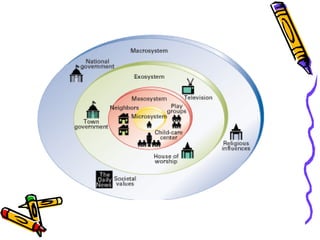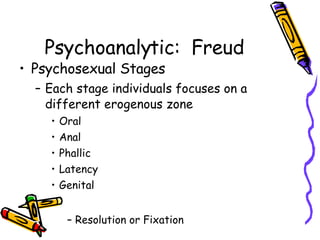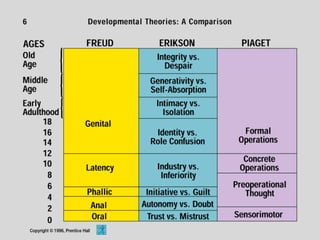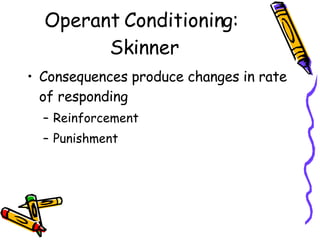Ch1
- 1. Chapter 1 Development Across the Lifespan An Introduction to Lifespan Development
- 2. What is lifespan development?? Development: The pattern of movement or change that begins at conception and continues throughout the life-span Includes: Growth Decline and dying
- 3. Four Topical Areas Studied Physical Cognitive Personality Emotional
- 4. Topical Areas of Focus Physical Development The body’s physical makeup including the brain, nervous system, muscles, and senses, and the need for food, drink, and sleep Malnutrition, reaction time “ Does the amount of sleep a college student gets each night affect stress?” “ How does dealing with a chronic illness affect a mothers behavior?”
- 5. Topical Areas of Focus Cognitive Development Growth and change in intellectual capabilities influence a person’s behavior Examples: Learning, memory, problem solving skills, and intelligence across the lifespan “ Does excessive television viewing effect intelligence? “ Can teenagers remember things that happened when they were toddlers?”
- 6. Topical Areas of Focus Personality Development Involves the ways that the enduring characteristics that differentiate one person from another change over the life span Examples Interactions with others, social relationships, individual qualities “ When does a sense of gender develop and does it change across the lifespan?”
- 7. Topical Areas of Focus Social Development Involves the way in which an individual’s interactions and social relationships grow, change, and remain stable over the course of life Example “ Do people become more isolated in late adulthood?”
- 8. The lifespan is usually divided into broad (albeit arbitrary) age ranges…
- 10. Individual Differences Exist Different rates of maturation Reach developmental milestones at different points Environmental factors, including culture, play a role in determining when events occur Age ranges are only averages, and some people will be above or below
- 11. The context of development takes a broad perspective… The ecological approach (Bronfenbrenner ) D ifferent environmental levels influence individuals at the same time Example (Isolated event) What do you do when your child is sick? You are a full-time employee and so is your significant other. Which systems are influencing your decision at this point?
- 12. Four Major Levels: Bronfenbrenner Microsystem: everyday immediate environment home, caregiver/parent, friends, teachers Mesosystem: connects parts of the microsystem parents linked to kids, students to teachers, friends to friends, bosses to employees
- 13. (Bronfenbrenner’s ecological approach continued) 3) Exosystem: represents broad influences local government, the community, schools, places of worship, local media 4) Macrosystem: represents larger cultural influences society in general, federal government, religious systems, political thought
- 16. Advantages to taking an ecological approach… Influences on development are interconnected Influences are multidimensional Broad cultural factors affect development
- 17. Particular Periods vs. Lifespan Approach * Early developmentalists focused on “infancy” & “adolescence.” Today the entire lifespan is seen as important for several reasons: growth and change are continuous throughout life each age has reciprocal influences on other ages
- 18. Nature vs. Nurture Nature refers to inherited traits, abilities, and capacities Includes maturation Nurture refers to the environmental influences that shape behavior What do developmentalists believe today ? That behavior is the result of nature and nurture combined
- 19. Theoretical Perspectives Theories explanations and predictions that provide a framework for understanding relationships 5 major theoretical perspectives used in lifespan development: psychodynamic behavioral cognitive humanistic evolutionary
- 20. Psychoanalytic: Freud Neurologist—based theory on the study of mentally ill patients Emphasized: Unconscious Early childhood experiences Personality Id Ego Superego
- 21. Personality Structures Id consists of instincts/drives unconscious component no contact with reality Ego Deals with the demands of reality Uses reasoning to make decisions (balance id/superego) No morality Superego Moral component of personality Conscience
- 22. Psychoanalytic: Freud Psychosexual Stages Each stage individuals focuses on a different erogenous zone Oral Anal Phallic Latency Genital Resolution or Fixation
- 24. Psychoanalytic: Erikson Psychosocial: Crisis based Each stage of life has a crisis that needs to be resolved Positive or negative resolution possible
- 26. Cognitive Theories: Piaget Organization involves the rearrangement of schemes is used to make sense of our world based on experience Adaptation involves the changing of cognitive schemes our thinking to further understanding through assimilation and accommodation Assimilation : Incorporation of new information into existing knowledge. Accommodation : Creation of new knowledge/modification of existing knowledge Adjustment to new information
- 28. Vygotsky’s Sociocultural Cognitive Theory Emphasizes how culture and social interaction guide: cognitive development development analysis the role of language social relations Cognitive skills originate in social relations and require sociocultural interaction Zone of proximal development
- 29. Information Processing Focuses on how the mind processes information Emphasizes that individuals manipulate information, monitor it, and strategize about it Store, retrieve, input, output, memory Thinking and memory is a continuous process Mind is analogous to a computer The physical brain is described as the computer’s hardware, cognition as its software.
- 30. Classical Conditioning: Pavlov Stimulus pairing Neutral stimulus Unconditioned response Conditioned stimulus Conditioned response Remember Pavlov
- 31. Operant Conditioning: Skinner Consequences produce changes in rate of responding Reinforcement Punishment
- 32. Social Cognitive Theory Reciprocal relationship between behavior, environment, and cognition Imitation and modeling
- 33. Eclectic Theoretical Orientation Does not follow any one theoretical approach Instead, selects and uses from each theory whatever is considered the best in it’s best features.
- 34. Types of Research: Descriptive Record and observation of behavior Observation Systematic Laboratory Naturalistic
- 35. Types of Research: Descriptive Surveys/Interviews Gathers information quickly Find out about attitudes, experiences, beliefs, and feelings Good interviews and surveys involve: specific and unambiguous questions means for checking the authenticity of the responses One limitation is socially acceptable answers Case Studies In-depth look at an individual to examine unique aspects of a person’s life that cannot be duplicated. Lack of generalizability
- 36. Types of Research: Correlational Describe the strength of the relationship between two (or more) variables Useful because the stronger the two events are correlated, the more effectively we can predict one from the other Correlation does not equal causation
- 37. Experimental research Allows researchers to determine the causes of behavior Procedures are carefully regulated (controlled by experimenter) “Cause” is the manipulated factor being studied “Effect” is the behavior that changes due to the manipulation .
- 38. Types of Research: Experimental Independent Variable (IV) is the manipulated, influential, experimental factor. Dependent Variable (DV) the factor that is measured in an experiment. It can change as the independent variable is manipulated Experimental Group group whose experience is manipulated. Control Group is a group that is treated in every way like the experimental group except for the manipulated factor
- 39. Cross-Sectional Approach Individuals of different ages are compared at one time Benefits: Time-efficient approach does not require time for the individuals to age Limitations: Provides no information change or stability
- 40. Time Span Research: longitudinal approach The same individuals are studied over a period of time in Provides information regarding stability and change over time Limitations Expensive and time-consuming. Attrition (Drop out potential) The subjects remaining could bias the results dissimilar from the ones that dropped out
- 41. Sequential Approach Combination of the cross-sectional and longitudinal approaches Individuals of different ages (cross-sectional) are tested over a period of time (longitudinal). This approach is complex, expensive, and time-consuming Helps eliminate issues with both other methods
- 42. Types of Correlational Studies Naturalistic Observation Case Studies Survey Research (Make sure you understand what each of these are!)
- 43. Theoretical and Applied Research THEORETICAL RESEARCH is research designed specifically to test some developmental explanation and expand scientific knowledge. APPLIED RESEARCH is research meant to provide practical solutions to immediate problems.
- 44. Ethics and Research Society for Research in Child Development and the American Psychological Association have developed ethical guidelines for researchers. - Freedom from harm -Informed consent -Use of deception -Maintenance of privacy
- 45. Don’t forget to keep up with your reading and studying! Review & Rethink section of book Key terms Practice tests in study guide, on disk that came with book, on companion website!












































